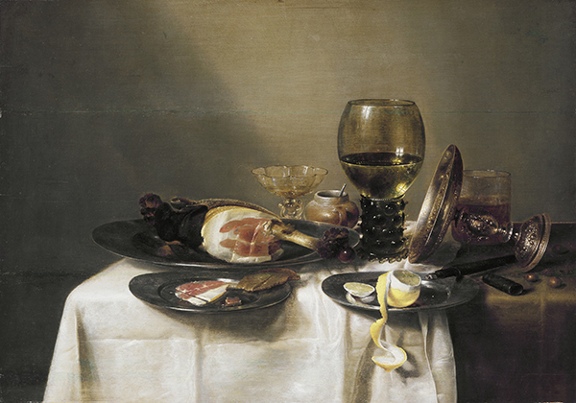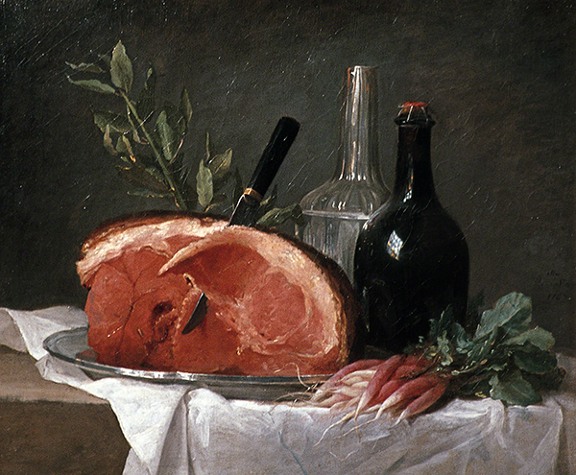National Meat Week 2024
National Meat Week, a celebration founded in 2005 by Chris Cantey and Erni Walker in Tallahassee, Florida, goes from 28 January to 4 February this year. It is meant to be a celebration of feasting on delicious meats, as well as a national festival of sampling a variety of meats in restaurants. A schedule of different meats is made and restaurants in participating cities can join in the fun. Fifteen to twenty cities participate and each assigns a “captain” to arrange the meat schedule. I actually don’t eat much meat, but it is my delight to find a work of art that features meat tastefully!
 |
| Willem Claesz. Heda (1593/1594–1680/1682, Netherlands), Still Life with Ham and a Roemer, ca. 1631–1634. Oil on wood panel, 23 3/16" x 32 7/16" (59 x 82.5 cm). © 2024 Philadelphia Museum of Art. (PMA-3145) |
William Claesz. Heda’s most famous works are his restrained still-life compositions with glass or metal vessels accompanied by a variety of foods, often on a draped cloth or Middle Eastern tapestry carpet. His compositions are invariably horizontal with contrasts in vertically and diagonally arranged objects, such as the roemer (a Dutch wine goblet) and metal stand in Still Life with Ham and a Roemer. Objects such as the roemer, fallen metal stand, and wine glass appear in this configuration in a number of his still-life works. Heda’s color palette, especially in this early period, tend to be dominated by subdued gray, golden yellow, and brown tones.
Heda often painted his selected objects in a disheveled state, such as the peeled lemon on the plate in Still Life with Ham and a Roemer. It is as if someone had just been seated at the table and left so Heda could paint the contents. Like most Dutch Baroque still life, the background is neutral with an ambient light. The objects and foods tend to be sumptuous—rather than humble—perhaps as a tribute to the prosperous middle class that supported his work. Underlying such worldly pleasures of food is the omnipresent reminder of the transience of life, as the food will eventually spoil and decay. Tables laden with large quantities of food are often called “banquet pieces” in the still-life genre, for obvious reasons.
Baroque is a term used to define art from around 1600 to 1750, a period in Western Europe that followed the Renaissance (ca. 1400–1600). During the Baroque period a variety of stylistic trends coexisted and often intermingled. The major trends were naturalism (bourgeois), classicism, and drama.
After Spanish domination since 1516, the Dutch provinces declared independence from Spain in 1581, establishing the Dutch Republic. While the southern Lowlands—Flanders (now Belgium) and Luxembourg—remained Catholic countries, the provinces of the Netherlands were Protestant after the Reformation (ca. 1517–1600).
Dutch art of the Baroque period maintained the same ideals of naturalism and detail as Northern Renaissance painting. However, in contrast to Catholic countries, Dutch artists developed their own hierarchy of subjects and styles, reflecting their reformed religion and the absence of a dominating church. While some religious subjects persisted, portraiture, genre scenes, landscape, and still life became the predominant subjects of Dutch painting.
Although still life as subject matter existed in painting of the ancient world, it was not a prominent subject matter in painting until after the Renaissance. After the Protestant Reformation, still life came into its own as a stand-alone subject matter. The genre of still life became immensely popular in Flanders and the Netherlands, partly because of the prohibition on religious subject matter that came about with the Reformation. Still life also grew in popularity because of the growing, better-educated middle class in the Low Countries that fostered a new crop of art patrons. Middle class patrons preferred recognizable, everyday imagery to historical, allegorical, or religious subjects.
Probably born in Haarlem, Heda spent his life there. Little evidence about his training in painting exists. Although he painted some portraits and genre scenes, he is most renowned for his luxurious still-life paintings. His earliest dated painting is from 1621. It is a vanitas still life in which the objects (often including a skull) allude to the brevity of life and destructive effects of clinging to physical riches. That painting reveals the influence of a possible teacher, the still-life painter Floris van Schooten (active 1617–1655). The wealth of images in his still-life paintings reflect the style of another still life painter, Floris van Dyck (1575–1651).
Heda pioneered his own brand of still-life painting based on a variety of influences, but he did not establish the genre for which he became most famous: the “banquet piece” and “breakfast piece.” Each of these categories contain objects related to certain meals, a popular genre at the time of his training.
 |
| Anne Vallayer-Coster (1744–1818 France), Still Life with Ham, 1767. Oil on canvas, 17 3/4" x 21 5/8" (45 x 55 cm). Gemäldegalerie (Stiftung Preussischer Kulturbesitz), Berlin. Photo © 2024 Dr Ronald V. Wiedenhoeft/Saskia, Ltd. (NFF-0580) |
Anne Vallayer-Coster—a pal of Marie Antoinette who was lucky to have escaped the guillotine during the French Revolution (1789–1799)—was certainly appreciated as a great still-life painter in her day. Her works were valued for their rich color and vigorous compositions that vary from needle-sharp realism to gestural realism, as seen in the banquet piece Still Life with Ham. Critics compared Vallayer-Coster favorably to Jean-Baptiste Siméon Chardin (1669–1779), although Chardin has overshadowed her in art history as the best 1700s French still-life painter. Vallayer-Coster, however, was more versatile in her compositions, able to please both noble and middle-class patrons with her virtuosity.
This humble still life showcases Vallayer-Coster’s brilliant balancing of color while using a tried-and-true arrangement of objects. This arrangement goes back to Dutch Baroque painting, which was much more in the Bourgeois Baroque category (more oriented toward the middle class). Her still-life subjects are usually arranged on a slight diagonal, in contrast to the frontal arrangement of most Dutch and Chardin examples. This charming work is in sharp contrast to her noble commissions that highlight Sèvres porcelain vessels and allusions to Neoclassical architecture. Nonetheless, it gives great dignity to a genre that was not considered up to snuff—compared with history painting and portraiture—by the standards of the French academy at one time.
Correlations to Davis Programs: Explorations in Art 2E Grade 1: 1.5; Explorations in Art 2E Grade 4: 6.8; Explorations in Art 2E Grade 5: 2.1, 2.2; Explorations in Art 2E Grade 6: 1.8; Experience Art 2.2; A Global Pursuit 2E: 5.2, 5.3; A Personal Journey 2E: 2.6; Experience Painting: pp. 124–130


Comments